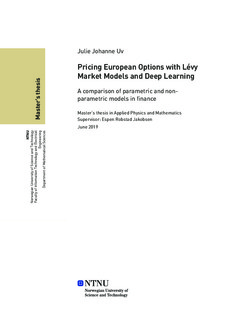Pricing European Options with Lévy Market Models and Deep Learning
Abstract
I denne oppgaven har fem Lévy-modeller og et kunstig nevralt nettverk blitt implementert for å sammenligne prising av europeiske kjøpsopsjoner mot den geometrisk brownske bevegelsesdynamikken i Black-Scholes-formelen. Statistisk analyse er utført på de underliggende aksjene, hvor det ble funnet at Lévy-modellene er en mer beskrivende modell enn den geometrisk brownske bevegelsen. Prissettingspressisjonen reflekterte imidlertid ikke dette. Derimot presterer den gemoetrisk brownske bevegelsesmodellen bedre enn flere av de andre modellene. Det blir også funnet at det nevrale nettverket presterer og generaliserer bra, til tross for få observasjoner, og overgår alle modellene for den lengste forfallsdatoen som er holdt utenfor treningsdataen. Til slutt konkluderes det med at mer data er nødvendig for å kunne si noe mer konkret. In this thesis, five Lévy models and a multilayer perceptron has been implemented to compare the pricing of European call options against the Geometric Brownian motion stock price dynamics of the Black-Scholes formula. Statistical analysis has been done on the underlying assets, where it was found that the Lévy models clearly are a better fit than the Geometric Brownian motion. However, the pricing performance did not reflect this. On the contrary, for the option prices, the Geometric Brownian motion outperforms several of the models. It is also found that the multilayer perceptron generalizes well, despite of few observations, and outperforms all the models for the longest maturity option which is held completely out of the training data. In the end, it is concluded that more data is needed to say anything definite.
